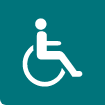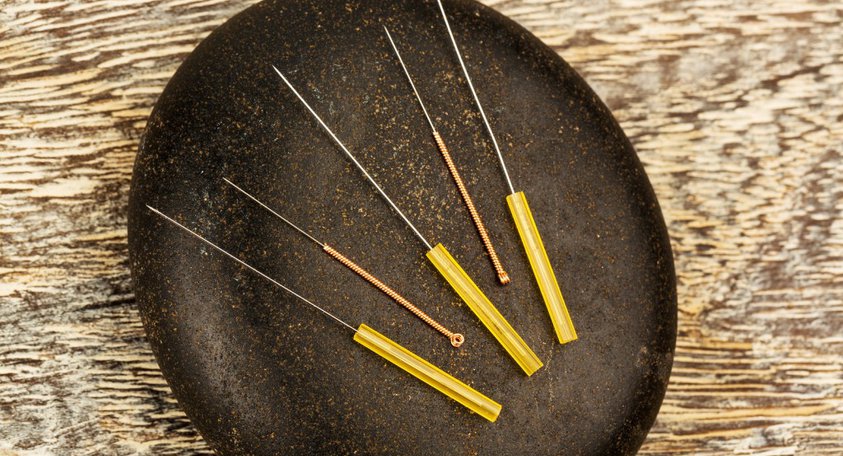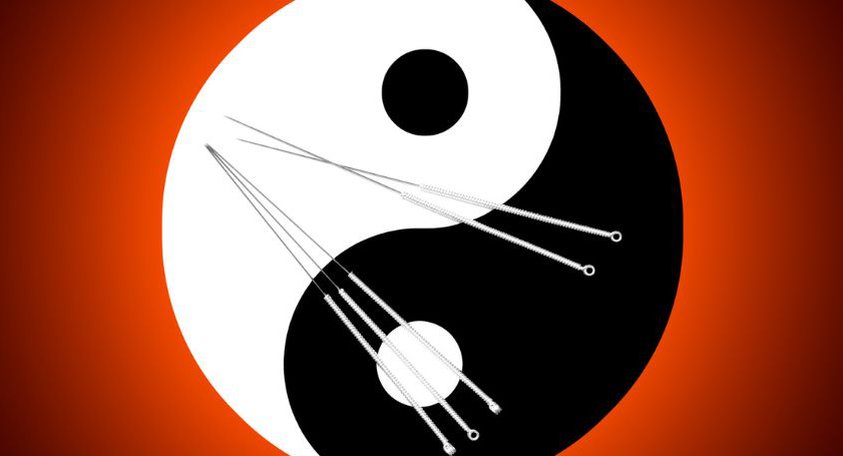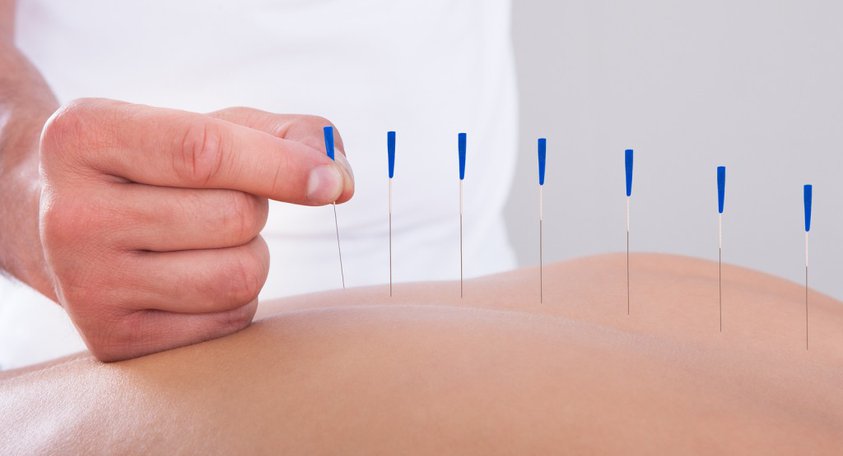Understanding Acupuncture for CRPS
Treatments for Complex Regional Pain Syndrome can also include alternative or complementary therapies. Burning Nights CRPS Support ran a series of guides to alternative therapies for CRPS and persistent pain to help with guiding you through the various therapies available.
In this articule we will explore if and how acupuncture can help Complex Regional Pain Syndrome (CRPS). Our beginners guide to acupuncture for CRPS goes into what acupuncture is, how it can help CRPS, what to expect from acupuncture, and what it involves.
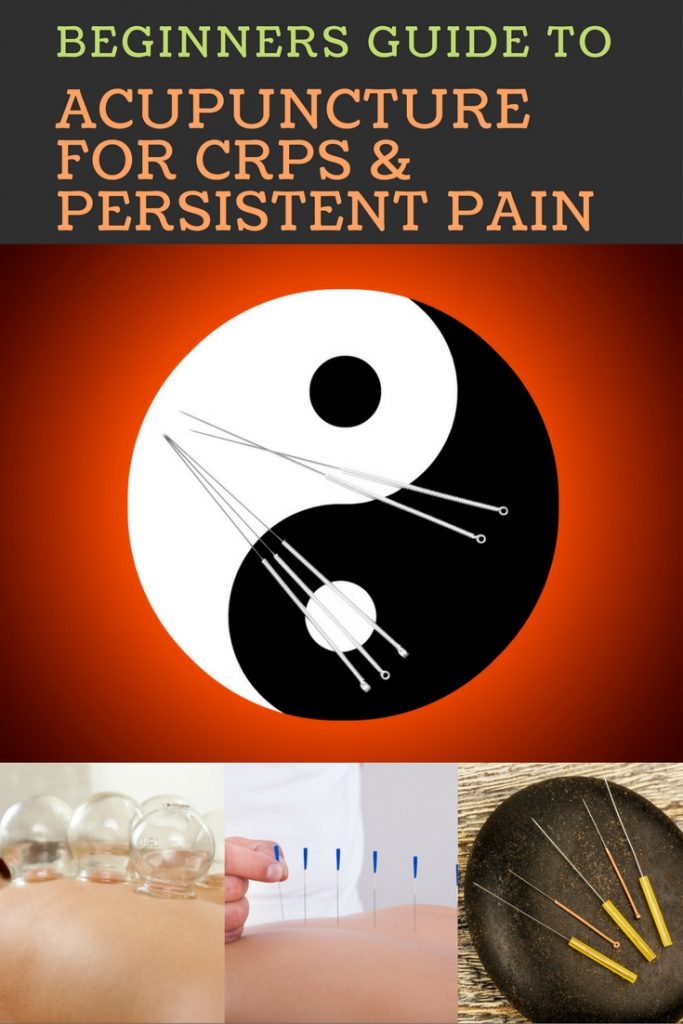
TO THE TOP
Where is acupuncture from?
Acupuncture or in literal terms 'needle puncture', has been used in China for literally thousands of years but has only been recorded for around 2,000 years. In the West, it has only been known to have been practiced for hundreds of years and the actual term 'Acupuncture' is a European term from Nagasaki, by a person called Willem Ten Rhyne in 1683 (According to the website 'In Plain Site.').
The traditional form of acupuncture forms part of what is known as Traditional Chinese Medicine (TCM), which is where the basis of the diagnosis and then treatment is that the body and also the mind should be in absolute balance. Many doctors and scientists still believe acupuncture to be quite a controversial form of alternative therapy for pain management as it is not certain how acupuncture works scientifically.
What is acupuncture?
The traditional form of acupuncture is where very fine, sterile needles are inserted into the person's skin at certain and precise points on the body and at varying depths. These points are called 'Acupuncture Points' or also 'Acupoints' and the lines or areas they are located in are called 'Meridians'.
The size of the needle is not as big as you imagine them to be, in fact they are only the width of a human hair and some are only a long as 0.13mm in length compared to a normal injection needle.
'Meridians' are invisible lines that are supposed to carry our energy throughout the body and according to a 'Natural Therapy Pages' website article, there are 12 Meridian Lines.
Watch this YouTube video: 'What Is Acupuncture?' by Dr Chad Morton
How does acupuncture work for CRPS or chronic pain?
It is known that any form of acupuncture has therapeutic benefits, including pain relief from various forms of acute and chronic pain. Many sufferers have said that the relief they felt from using acupuncture tended not to be permanent, instead only lasting a few hours. However, in a study by Alejandro Katz using needles and micro-current, he found that within 12 treatments the CRPS sufferers' pain began to improve where other regular treatments had previously failed.
In another research article, it was found during the study that 'real' acupuncture compared to 'sham' acupuncture was a fairly effective treatment for CRPS sufferers. (Korpan et al.)
The thought behind acupuncture for CRPS and Chronic Pain is that it helps promote relaxation, thereby letting the blood in our body flow more easily and correctly. But, remember, using acupuncture is for trying to treat the physical aspects of CRPS rather than trying to treat the neurological.
Acupuncture is basically stimulating our nervous system, which in turn releases neurochemical molecules and if certain acupuncture points are stimulated it has been found that it can affect the certain areas of the brain that are involved in pain and stress, thereby reducing the sensitivity to stress and pain. This is important for CRPS sufferers as one of the symptoms associated with CRPS is hypersensitivity / allodynia. It will also help to relax you as well.
Acupuncture is available on the UK NHS for free, speak to either your GP or pain management specialist and ask for a referral. In the USA, as it is considered to be an alternative therapy, many insurance companies won't pay for acupuncture, so you would be self-funding which could be expensive. In Australia, acupuncturists should be registered on the Australian Acupuncture and Chinese Medicine Association Ltd or AACMA. Please speak to your doctor or pain specialist about having acupuncture and whether there is a cost for it. If you have private health insurance in any country around the world, please check with your insurance company whether they will pay for acupuncture before going to an appointment, just in case you have to pay for the treatment.
Some Burning Nights CRPS Support volunteers have tried Traditional Acupuncture for CRPS. Most received the treatment during physiotherapy sessions at their local hospital and some found that it helped to have a slightly more restful 4-hour sleep. But, we do suggest seeking out a trained professional outside the healthcare system and someone who only specialises in acupuncture or Traditional Chinese Medicine.
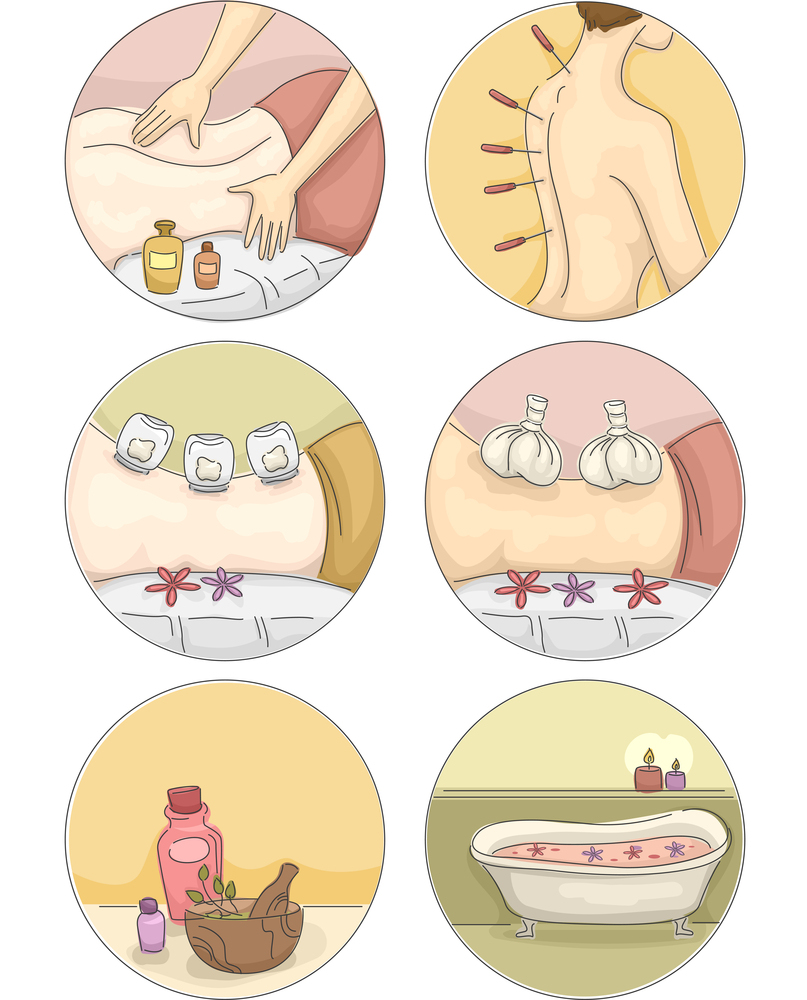
Different forms of acupuncture
There are many forms of Acupuncture and the traditional form using very fine needles is just 1 of them, there is a form of Veterinary Acupuncture. Below is just a few different forms:
- MEDICAL ACUPUNCTURE – When a doctor in the Western world performs acupuncture. It is used for pain relief and pain management and electrical stimulation can be added to the needles to simulate a nerve block.
- TRADITIONAL CHINESE ACUPUNCTURE (TCM) – The most common form and it is to help balance the body.
- AURICULAR ACUPUNCTURE – When only the ear is used to help treat the whole body. Again, this is used to help control pain and pain management as well as addictions like alcohol and drugs.
- KOREAN HAND ACUPUNCTURE – In this form of acupuncture, only the hand is used to help to treat the whole body. Certain points on the hand correspond to areas of the body.
- JAPANESE STYLE ACUPUNCTURE – This is a little more delicate form than the TCM. Fewer needles are used with far less stimulation and the needles are thinner. Japanese Acupuncture is also called Classical Acupuncture and focuses on the application of the Five Element Theory.
- KOREAN ACUPUNCTURE – A similar approach to the Japanese style, the difference being the number of needles used, which is usually around 100 needles in just the one session.
Source: The Acupuncture Center Website
Other variations of the acuuncture technique
There are variations on the type of Acupuncture technique that is available. These include, but are not limited to:
Chinese Scalp Acupuncture
- The fundamentals of scalp acupuncture therapy were reviewed by Lu Shoukang, of the Beijing College of Acupuncture, Moxibustion, Orthopedics, and Traumatology. According to the review, the technique is predominantly a small-needle therapy in which shu points in the scalp are treated. Shu points refer to "stream" points where the qi of the internal organs is infused. In the system of body acupuncture, there are 5 shu points (one for each element) on each of the 12 meridians (below the elbow or below the knee) plus the back shu points, which are each located in the vicinity of one of the internal organs.
- According to the theory of channels and collaterals, shu points in the head can be used to treat diseases of the whole body. Scalp acupuncture is one of several specialised acupuncture techniques with a specific body location, taking its place alongside ear, nose, hand, foot, and wrist/ankle acupuncture. Although the scalp has numerous traditionally-identified acupuncture points along several of the major meridians (notably the stomach, bladder, gallbladder, triple burner, and governing vessel), modern scalp acupuncture differs from traditional acupuncture therapy. There are three basic features of scalp acupuncture that differentiate it from body acupuncture:
1. Treatment zones have been mapped onto the scalp that are associated with body functions and broad body regions. The zones include a few standard acupuncture points, but the treatment principle for point selection is usually not based on the traditional indication for the point or associated meridian. In general, within a defined zone, the forward part of the zone (nearer the face) is used to treat the upper body, while the rear portion of the zone is used to treat the lower body. Functional zones, such as sensory, memory, and motor, are usually located at the back and sides of the scalp.
2. In scalp acupuncture, the needles are to be inserted within a thin layer of loose tissue beneath the scalp surface, at a low angle of about 15–30 degrees, involving an insertion distance of about 1 cun [the cun is a variable unit of measure based on body size; about one inch for an adult]. Standard acupuncture of scalp points normally involves subcutaneous insertion up to a depth 1/2 cun or less (about 0.3–0.5 inches for an adult) at a high angle of 60–90 degrees.
3. For scalp acupuncture, the needles are to be subjected to rapid stimulation, which may be carried out in a variety of ways, including pulling/thrusting, twirling, and electro-stimulation. Standard acupuncture applied to scalp points usually involves less rapid stimulation or moxibustion as the main stimulation technique. When using manual manipulation in modern scalp acupuncture, it is common to stimulate the needles for 2–3 minutes at a time, with a rest period of 5–10 minutes between stimulations.
(Dharmananda, S. December 2000)
Laser Acupuncture
- A laser is used instead of the very fine needles along the Meridians.
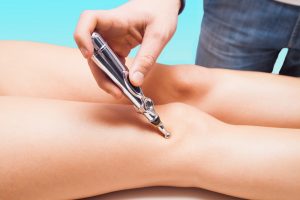
Electro-acupuncture
- Again, going along the Meridians, but this time using an electric current.
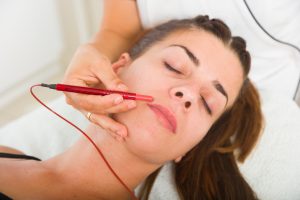
Acupressure
- Blunt or dull pressure is applied along the same Meridians, but there is no puncture of the skin.
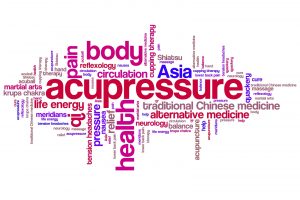
Moxibustion
- In this style of acupuncture, there are different materials burnt on the skin along the Meridians. Heat is applied to the Meridian using the Moxi, which is a therapeutic herb, then heat lamps could be used to relax muscles.
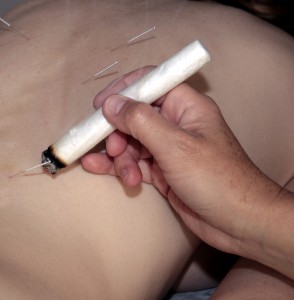
Cupping and Gua Sha
There are also other techniques, such as: Cupping, where small glass cups with a seal are put on your skin stimulating the body's blood flow; Tui Na (or tuina), a form of massage to relieve any tension in your muscles that also stimulates the acupressure points; or even Gua Sha, which isn't recommended for CRPS or chronic pain patients, as it involves actual scraping of your skin to produce a light bruising.
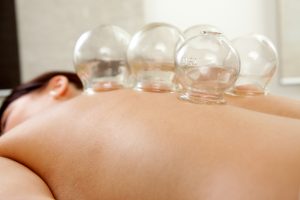
What happens at an acupuncture session?
Before the Acupuncture Session
Before going for your acupuncture session, there are somethings you need to remember:
- Let your acupuncturist know if you have never tried acupuncture before, this will let the person scheduling your appointment allow for extra session time for explanations of what happens.
- Schedule your appointment sensibly and don’t have the session either before or after a strenuous activity.
- Don't go to the session without eating or straight after a heavy, spicy or fried meal.
- Don't drink alcohol or coffee before your session.
- Wear comfortable, easy clothes as the most common acupuncture points are on the legs and lower arms.
- Make a list of your current medication including any natural remedies.
- Make a list of any important medical incidents in your life, e.g. serious injuries, medical problems current and past. Also list any significant family medical problems.
- Don't be on the last minute getting to your appointment as it will make you more stressed, tense and anxious.
- When you get to your appointment, turn OFF your mobile phone (cell phone), don’t just leave it on vibrate!
- Try to get to your appointment approximately 5-10 minutes before your session to give you time to relax.
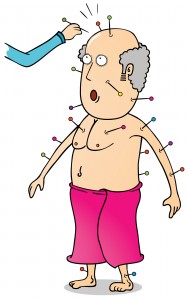
During an acupuncture session
The first session will tend to last around one hour. After this, the sessions will be approximately 30-50 minutes, but it will depend on who you go to see.
- During the first session you will be asked a number of questions relating to your current health, lifestyle, sleep pattern, medication especially blood thinners and important medical incidents that have happened in your life.
- The acupuncturist will take your pulse using both your wrists, they may examine your tongue and feel for muscular tension or areas of pain.
- You will also be asked a number of questions about your current complaint and be asked to describe what the various symptoms feel like, how long it has been going on, frequency and the severity.
- You should tell your acupuncturist if you have tried any other alternative therapies and whether they have worked or not.
- The acupuncturist will give you a diagnosis and treatment plan after they have collated all your answers to the various questions they have asked.
- You will be asked to lie down on a bed either face up, face down or on your side. This all depends on where the needles are going to be inserted.
- If you are having the Traditional form of acupuncture, the acupuncturist will be using very fine pre-sterilised needles that are only for one use then are thrown away.
- The needles are placed in specific acupuncture points on your body, which may not necessarily be near to where your pain is.
- Needling techniques of acupuncturists can vary slightly, however most are quite gentle and some people feel very little as each one is introduced into the skin. You could feel a slight pinch that does go after a couple of moments. But each person feels things differently and at varying degrees of sensitivity. Please tell your acupuncturist immediately if anything does hurt you or if you can't take the needle in a certain place.
- You should be able to feel a deep aching feeling when the needle is at the right depth.
- The needles will usually remain in place for approximately 20-40 minutes and you should feel comfortable during this time.
After the acupuncture session
After an acupuncture session this is usually what happens:
- The acupuncturist will most probably give you some ways to help improve the effects long term of your treatment, which could include elements such as dietary alterations or changes to your daily routine.
- They could also ask to refer you to other specialists or healthcare professionals, depending on your particular problem.
- After your treatment, as acupuncture is considered relaxing, you could feel calm, sleepy or tired.
- You may not get any relief immediately after treatment. It could be a few hours later instead.
- Your relief (if you have any) depends on the severity of your problem/s.
- If you get some relief post-treatment, it may last a few hours and possibly longer after each treatment.
- If you are going to exercise, please do only light exercise not vigorous.
- Try and give your body time to rest following acupuncture treatment, you don’t need to go and lie down to sleep but having a short nap after acupuncture treatment will give you body the time it needs to rest.
- If you can, don’t drink alcohol for a few hours after the treatment.
- Use a heat pack if you feel it helps give you more or better relief.
- Avoid eating any sugar or processed foods after treatment as it will put back toxins into your body after the acupuncture has taken them out.
Are there any side effects?
Generally, acupuncture doesn't have many side effects, but if you do have any then they tend to be mild. Side effects can include:
- Sleepiness and feeling very tired, please take care when driving or using heavy machinery
- Slight nausea
- Light-headedness which could on rare occasions cause fainting
- Muscle ache
- Soreness where the needles were put in (Traditional form of Acupuncture)
- Temporary slight bruising (this is especially concerning Cupping and Gua Sha), this bruising tends to be painless and clears after a couple of days
- Feelings of being extra emotional, e.g. crying, extra sensitive
On some rare occasions, your current CRPS symptoms including chronic pain could get worse following any treatment such as a pain flare up. Hopefully, this won't last for more than an hour or two and then give you relief. If you feel your pain flare is lasting longer than a couple of hours, then you need to contact your acupuncturist and get advice from them.
As you can read in this beginners guide to acupuncture for CRPS and persistent pain, there's a lot of good information on all aspects of trying this form of Alternative Therapy.
Finally...
Please check out some of our other CRPS articles
We have a number of other CRPS articles that you may want to read:
Disclaimer
Please remember we are not doctors or medically trained. Please always seek medical advice prior to starting anything new.
Acupuncture and the other types of alternative therapies are not meant to replace your typical pain management treatments, they are used in addition to. Always speak to your healthcare specialists before trying any other treatments in case there are any contradictions.
- Acupuncture Awareness (2016) ‘Acupuncture Awareness Week,’ Acupuncture Awareness website. Available from: <http://www.introducingacupuncture.co.uk/>
- Acupuncture Today (2016) ‘The ABCs of Traditional Chinese Medicine & Acupuncture,’ Acupuncture Today. 2016. Available from: <http://www.acupuncturetoday.com/abc/>
- Bastos, J.L. et al. (2013) ‘Effect of acupuncture at tender points for the management of fibromyalgia syndrome: a case series,’ Journal of Acupuncture Meridian Stud. 2013, June. Vol 6(3) pp 163-168. FULL TEXT Available from: <http://www.jams-kpi.com/article/S2005-2901(13)00051-4/pdf>
- British Acupuncture Council (2016) ‘Ask an expert about acupuncture and any side effects,’ British Acupuncture Council website. Available from: <http://www.acupuncture.org.uk/category/public-content/public-ask-an-expert/ask-an-expert-about-acupuncture/ask-an-expert-about-acupuncture-side-effects.html>
- Calabro, S. (2012) ‘How to take care of yourself after an acupuncture treatment,’ AcuTake. 2012, May 29. Available from: <http://acutakehealth.com/how-to-take-care-of-yourself-after-an-acupuncture-treatment>
- Dharmananda, S. & Vickers, E. (2000) ‘Synopsis of Scalp Acupuncture,’ Institute for Traditional Medicine, Portland, OR. December 2000. Available from: <http://www.itmonline.org/arts/newscalp.htm>
- Hommer, D.H. (2012) “Chinese Scalp acupuncture relieves pain and restores function in Complex Regional Pain Syndrome” NCBI Pub MD.gov, 177 (10), 1231-4. Abstract Retrieved from: http://www.ncbi.nlm.nih.gov/pubmed/23113454
- Katz, A. (2001) ‘Complex Regional Pain Syndrome ,’ Acupuncture Today. April 2001. Vol 02 Issue 04. Available from: <http://www.acupuncturetoday.com/mpacms/at/article.php?id=27704>
- Korpan, M.I, Dezu, Y., Schneider, B. et al. (1999) “Acupuncture In The Treatment of Post-Traumatic Pain Syndrome.”Acta Orthoapedica Belgica, Volume 65 (2) Retrieved from: http://actaorthopaedica.be/acta/download/1999-2/10427802.pdf
- NCCIH (2016) ‘Acupuncture: In depth,’ NCCIH website. Updated January 2016. Available from: < https://nccih.nih.gov/health/acupuncture/introduction>
- Nordqvist, C (2016) ‘Acupuncture: How does Acupuncture work?’ Medical News Today (MNT). 2016, 17 February. Available from: <http://www.medicalnewstoday.com/articles/156488.php>
